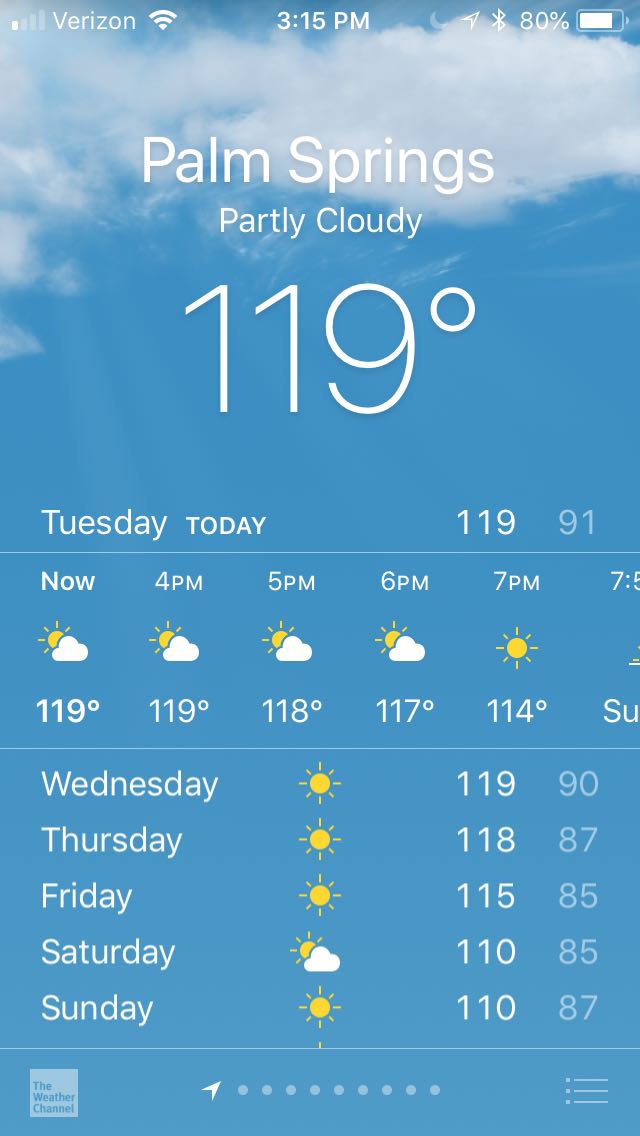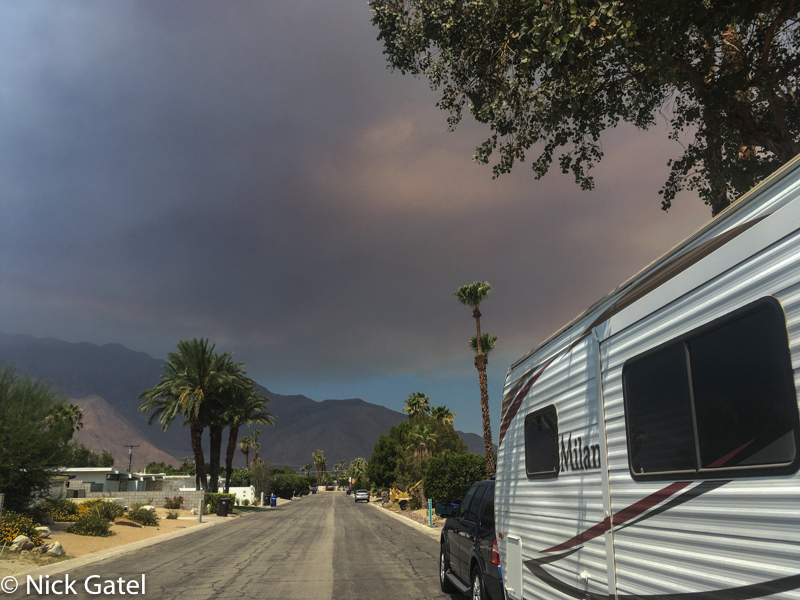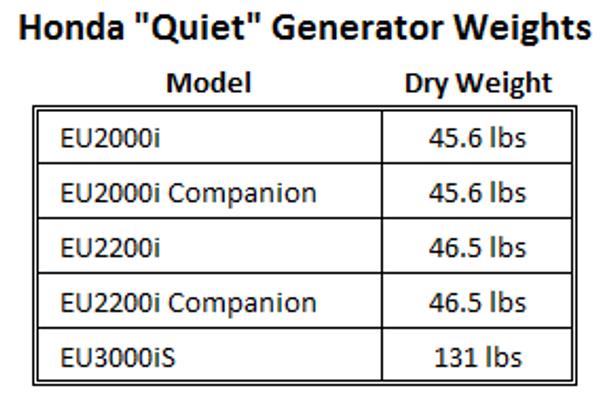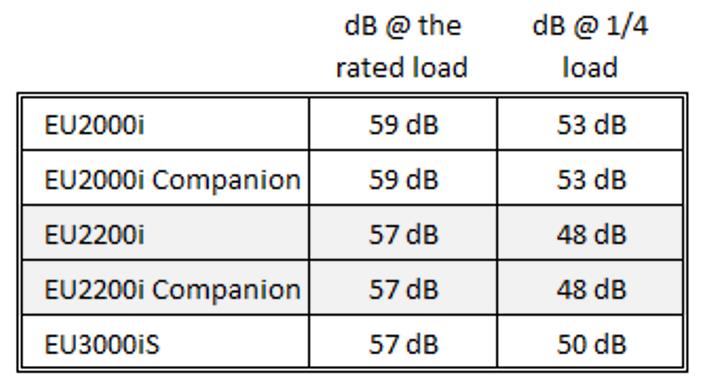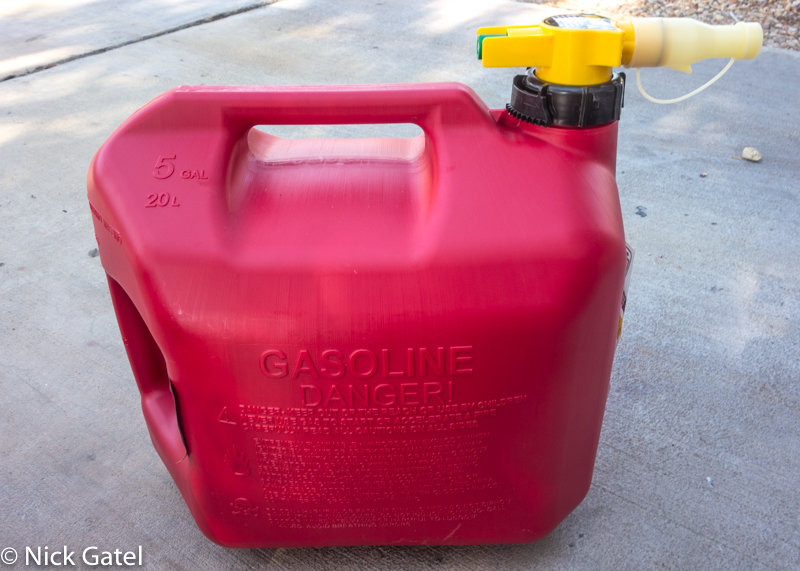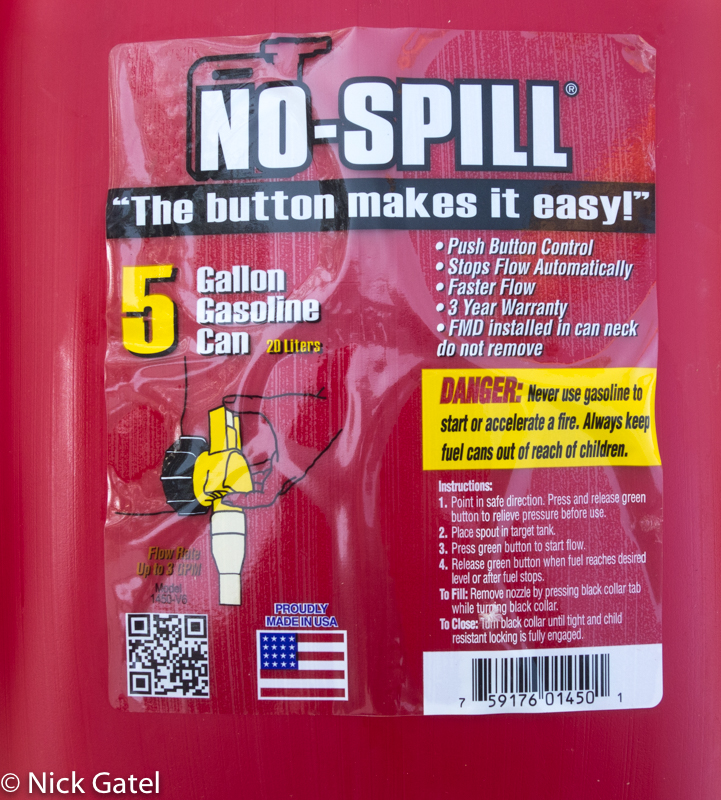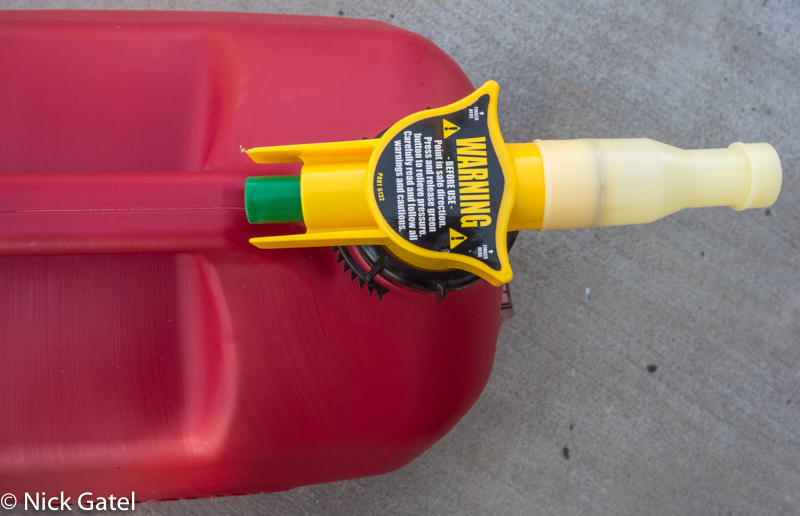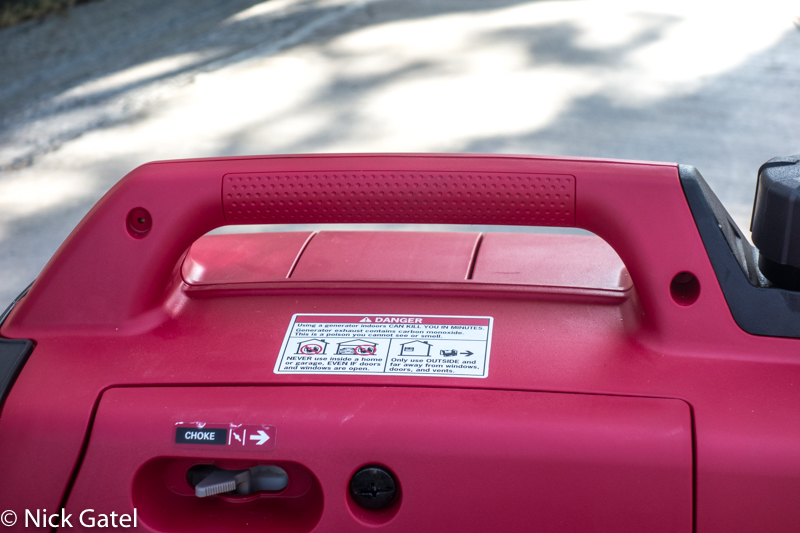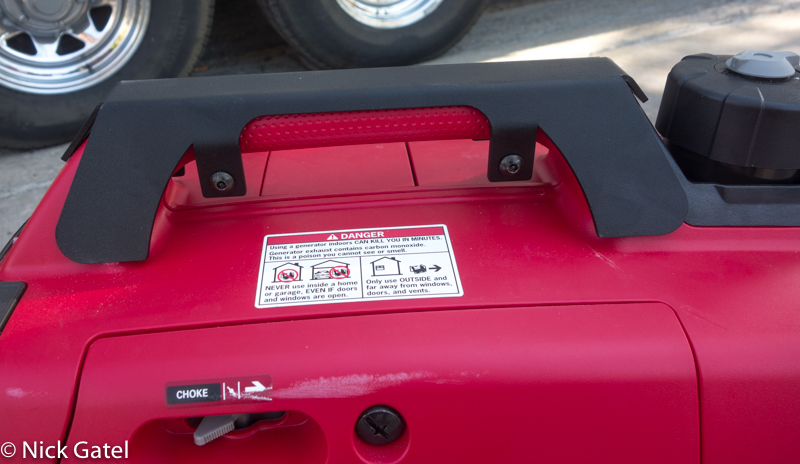Last week was hot at home.
The temperature wasn’t bad for us desert dwellers. Then a large wildfire starting burning in Idyllwild. Although the fire was on the other side of the San Jacinto Mountains, it was less than 15 miles from our house as the crow flies. No danger of fire at home, but the air quality was poor.
So we decided to leave. Given the local mountains were out of the question and the Southern Sierra further and crowded, we headed to Lake Mead.
Generators for the PopUpBackpacker?
This trip was a good test for our new Honda “EU” generators.
I know, I know. I’ve been pretty critical of generators in the past. However, over the past 15 years I’ve kept up with the technology and made the purchase decision based on a LOT of research and thought.
No, we aren’t giving up on our solar system. We can handle hot days, but when the nights don’t drop below 90F it is getting more difficult for we two 60-something year olds. The evaporative cooler just doesn’t cut the mustard if the humidity is high as I wrote a couple years ago.
So I decided to explore a generator option so we can continue to camp in deserts year round, even if it is around 120F.
Here are the results of my research.
Generator Considerations
Four things were of importance:
- What size, e.g., how many rated watts
- Durability and reliability
- Weight (I’m getting old)
- Noise
How to Determine What Size Generator
For us, the only need a generator can fulfill is running our roof-top air conditioner in really hot weather. However, if we run the A/C and any other electrical consumers the inverter would normally handle, the generator will have to power those other consumers too because our automatic transfer switch sends power to all the 120 volt circuits in camper; thus we can only use one power source at a time. You can read about how were wired our camper in these two posts: Milan Solar System and How to Choose an Inverter.
Starting Watts versus Running Watts
Another consideration is to understand that it takes much more power to start an electrical device like an air conditioner than it takes to run it once it has started. What is helpful, or sometimes confusing, is generators are normally rated by the starting watts. A Honda EU2000i generator can supply 2,000 watts of starting power for a short period of time and then it will provide 1,600 watts of continuous power running at full throttle. The table below is an approximation of what is required to run a typical RV air conditioning unit.
We have a 13,500 btu (British thermal units) air conditioner, so I was looking for a generator capable of 3,000 watts minimum.
The table isn’t the absolute authority. Some people have been able to run 13.5K units with a 2,000 watt Honda EU2000i. Usually this requires installing a hard start capacitor in the air conditioning unit and operating it at altitudes under 1,000 feet elevation. Of course not all 13.5K units will start with a 2,000 watt unit. Additionally, if it does start, the generator will be operating at close to its overload threshold and could possibly damage both the A/C unit and the generator.
We ended up with two generators that are connected together with a Parallel cable kit. A Honda EU2200i (2,200 watts) and a EU2000i Companion (2,000 watts) with a total starting wattage of 4,200 watts and running watts of 3,400. This give us plenty of margin to run other things if needed. Also, running our A/C uses less than half of the maximum available meaning lower fuel consumption and lower noise levels.
Honda has a wattage calculator
https://powerequipment.honda.com/generators/wattage-calculator
that is helpful for people trying to calculate their power needs.
Durability and Reliability
There are many manufacturers of portable generators. Most RV owners want a “quiet” unit, and Honda and Yamaha are the cream of the crop when it comes to durability and reliability – and their offerings are often twice as much as the low cost competitors.
Honda built the first portable generator in 1965, created the first generator with an inverter, and released the first microprocessor controlled sine-wave inverter generator in 1998, and released the legendary EU2000i in 1999.
In addition to Honda’s industry leading generators, I chose Honda because of the large dealer network available should our generators need warranty service, and my past experience with Honda products has been stellar.
All the “off-brands” I checked do not have their own service network and rely on independent companies to service their units. One of the largest low cost competitors has two “service outlets” in my area. When I checked with both, they were actually solar panel installation companies and do not service generators at all, contrary to the manufacturer’s website. Who needs that kind of problem?
I also spoke with several retailers who sell Honda and other brand generators. All told me they never have problems with the Honda units, however the other brands are a different story and their policy is that once the customer leaves with an off-brand they won’t even look at a defective unit unless the customer pays for the service! Once an off brand leaves the store the retailer is done unless the customer buys an additional warranty from the retailer. Incredible. Caveat emptor!!
Our Honda generators have a 3 year warranty.
I read many, many customer reviews on several brands of generators – you know – the 1-5 Star reviews. Now, keep in mind that some 5-star reviewers get some sort of compensation or perks and some 1 & 2 star reviewers can’t read the instructions or didn’t read all the specifications and expected more than they should have. Given this, there are many happy owners of “off-brand” generators. Unfortunately there are too many 1 & 2 star reviewers and this should be a red flag for potential purchasers. I took the advice of one who wrote, “Save yourself some headache. Buy a Honda product instead.”
Weight
Most of the “quiet” portable generators in the 2,000-2,500 watt range weigh under 50lbs. But the 3,000 watt units weigh considerably more. Honda is no exception.
The combined cost of our two generators was exactly the same as we would have had to pay for a 3,000 watt Honda EU3000iS (except we had to pay around $30 for a parallel kit to connect our generators). The EU3000iS is bulky and heavy at 131 lbs, too much for me to be lifting and moving around.
The EU2200i and EU2000i Companion are compact and light, plus they provide much more power output when connected with the parallel cables.
Noise (or “quietness”)
We need to discuss decibels (dB), which can be kind of complicated and scientific, so I’ll be somewhat unscientific. Actually the specifications to be discussed in this post are dB(A), but we’ll just use dB as decibels for discussion, so we can all be non-scientific. Below is a decibel table that provides the sound levels of several activities. Normal conversation at 3 feet distance is 60-70 decibels.
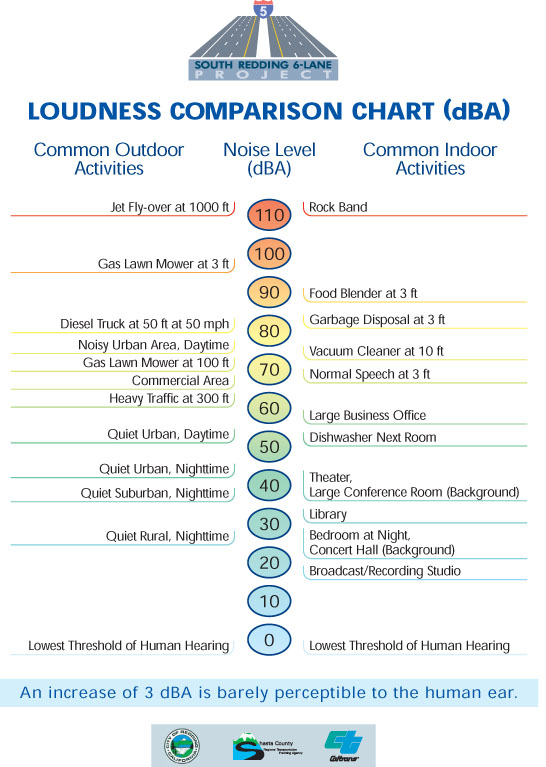
Decibels are calculated using logarithms of base 10. What this means for our conversation is: 60db is 10 times louder than 50dB. 70db is 100 times as loud as 50dB. Let’s take a look at the Honda generators and their noise levels. Most generator manufacturer’s measure the noise level 7 meters (23 feet) from the generator with the exhaust pipe pointing away from the microphone. This somewhat standardized measurement really means that the noise is actually louder than the table above but not excessively so.
Yeah, right, Nick. But you have two generators so if you add them up the decibels are over 100 dB!!
Nope. Let’s assume that both generators are creating 55 dB of noise. Two generators are twice as loud as one, but it’s a logarithm scale, so twice as loud is only 3 dB more. So the two combined will be creating a total of 58 dB (trust me on this… you don’t want me posting a bunch of formulas). If you go back and look at the Loudness Comparison Chart of Activities above, you will see at the bottom a note that an increase of 3 dB is barely perceptible to the human ear.
Honda EU Generator Review
By now you will have probably noticed I have a EU2200i and a EU2000i Companion generator. This year Honda quit making the EU2000 series replacing it with the EU2200 series. So why did I buy one of each? Price. The EU2200i was on sale but not the EU2200i Companion. I’ll explain the “Companion” units a little later. I got a EU2000i Companion for $100 less. Yes, I’m a frugal consumer 😉
Inverter Generators
Like most of the “quiet” portable generators on the market, the Honda EU series are “inverter” generators. Unlike conventional generators that run at only one speed and produce poor quality alternating current (AC is the same current you have in your house). Inverter generators produce AC voltage, convert it to DC voltage, then an inverter in the generator converts it back into pure sine wave AC voltage – the same high quality electricity that is delivered to your house enabling you to use sensitive electronic equipment like computers. Also, these inverter generators are able to change the speed according to electrical loads, which improves gas consumption and lowers noise levels.
This is another reason why I chose a Honda, because the microprocessors they use are top notch and less likely to fail like the “off-brands.” Let’s face it; most of the portable inverter generators are pretty much copies of what Honda has done.
EU2200i Inverter Generator
Very similar to the original EU2000i, the EU2200i is a new model replacing the EU2000i that has been in production for 19 years. Functionally for the consumer, the EU2200i is almost identical to the EU2000i. Unless you are a tech-geek there is little exterior difference, except one: the fuel shut-off switch.
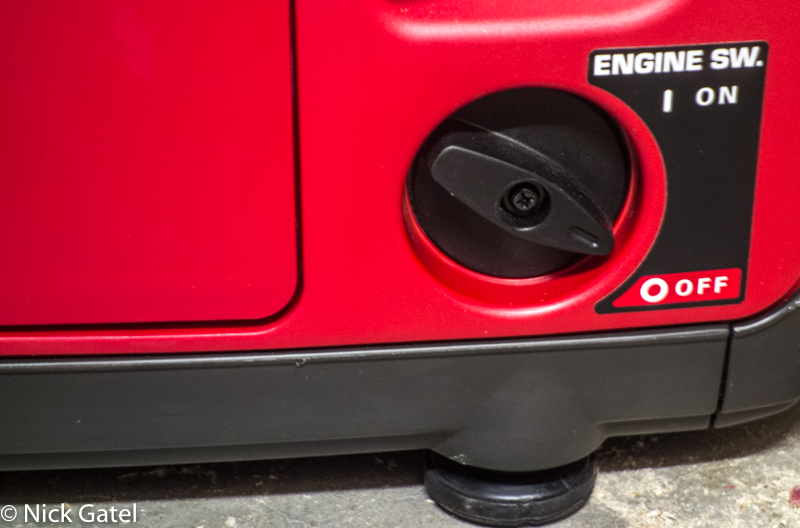
The EU2000i Engine Switch has two positions: On and Off. The switch is turned to the “On” position, the recoil rope is pulled and the generator starts. To turn the generator off, simply turn the switch to “Off.”
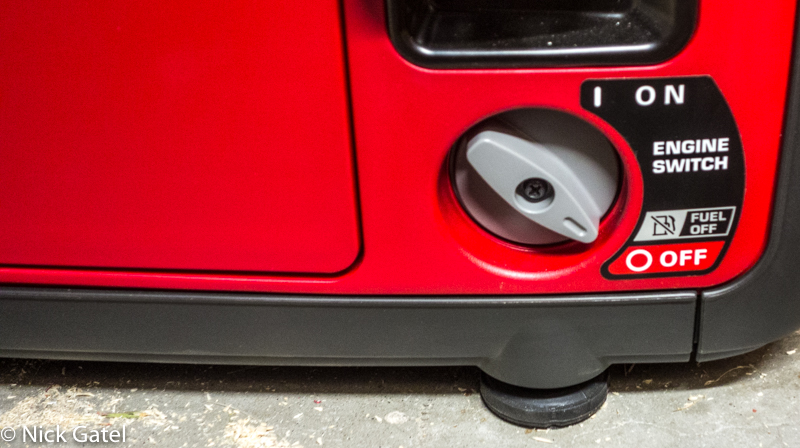
The EU2200i Engine Switch has three positions: On, Fuel Off, and Off. The switch is turned to the “On” position, the recoil rope is pulled and the generator starts. To turn the generator off, one simply turns the switch to “Off.” The “Fuel Off Switch” allows the generator to continue running until most of the fuel in the carburetor is consumed. Honda probably added this feature to compete with Yamaha’s portable generators that have this feature. The only time you would want to run the generator out of fuel is when the unit is being prepared for storage – but – you still need to manually drain the carburetor by opening the carburetor drain screw, then drain the fuel pump and gas tank. So the Fuel Off switch is mostly a marketing feature.
Control Panels
The control panels on the EU2000i series and the EU2200i are identical.
EU2200i Control Panel
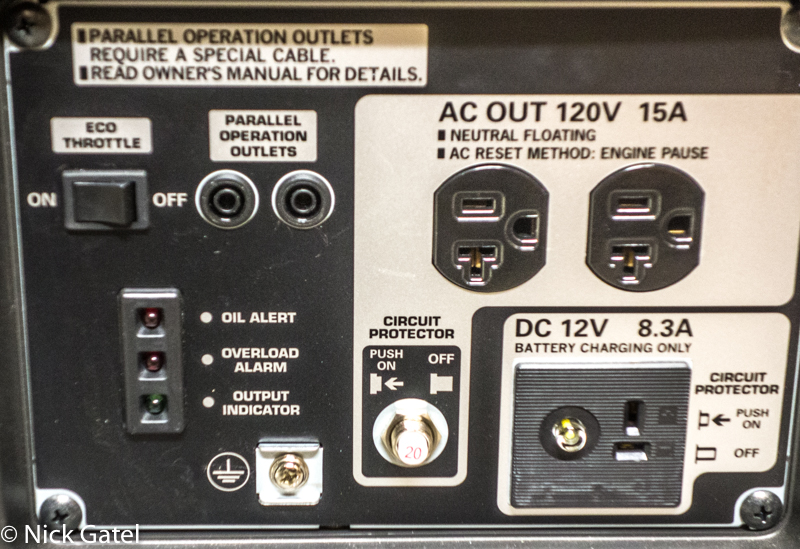
When the ECO THROTTLE switch is set to “On” the generator will change speeds dependent upon the electrical load. This improves fuel economy and lowers the noise level. When two generators are connected with the parallel kit, both switches should be ON or OFF at the same time. If loads are near the rated capacity, the switches should be turned to OFF. When running our air conditioner we set both switches to the ON position after the generator has been running for a few minutes. Works perfectly.
There are three INDICATOR LIGHTS on the panel:
- Oil Alert (red light): If the oil level is low the light will come on and the generator will shut down to prevent damage
- Overload Alarm (red light): If the electrical load exceeds capacity or if there is a short in a connected appliance, the light will come on, and the current to the connected appliance will be shut off, and the engine will continue to run
- Output Indicator (green): This light will be on when the generator is running and operating properly.
There are two AC RECEPTACLES and the total electrical load cannot exceed 2,200 watts start up or 1800 watts continuous run. The maximum rated AC current is 15 amps.
To connect another generator, the optional Honda Parallel kit is required. Two plugs are inserted into the PARALLEL OPERATION OUTLETS IN each generator, plus a ground wire between both. The parallel kit also comes with a twist-lock 30 amp connector for the Companion unit.
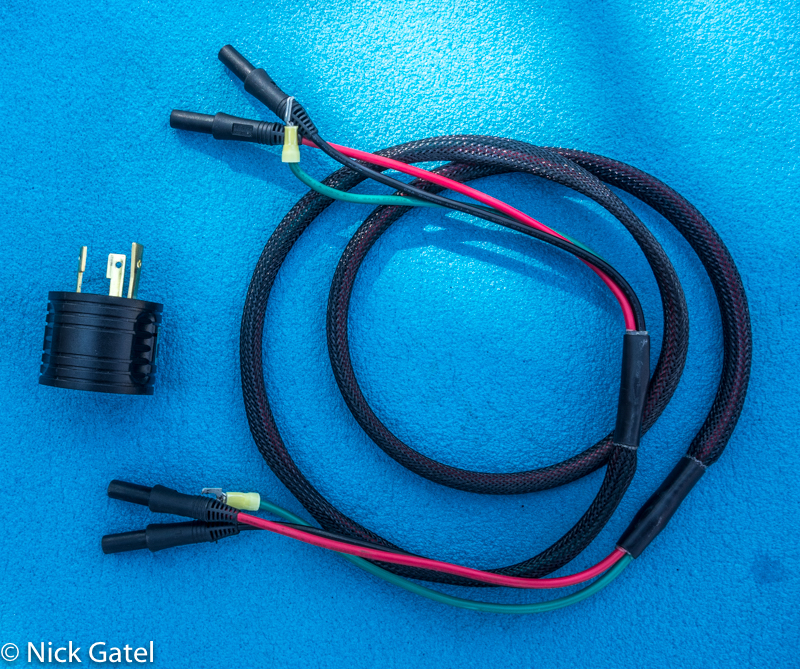
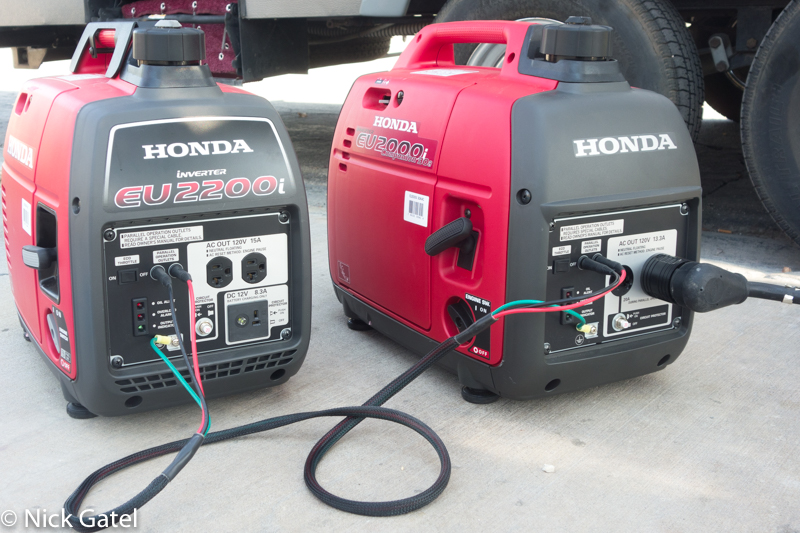
There is also a 12 volt DC, 8.3 amp BATTERY CHARGING ONLY receptacle, which requires an optional cable.
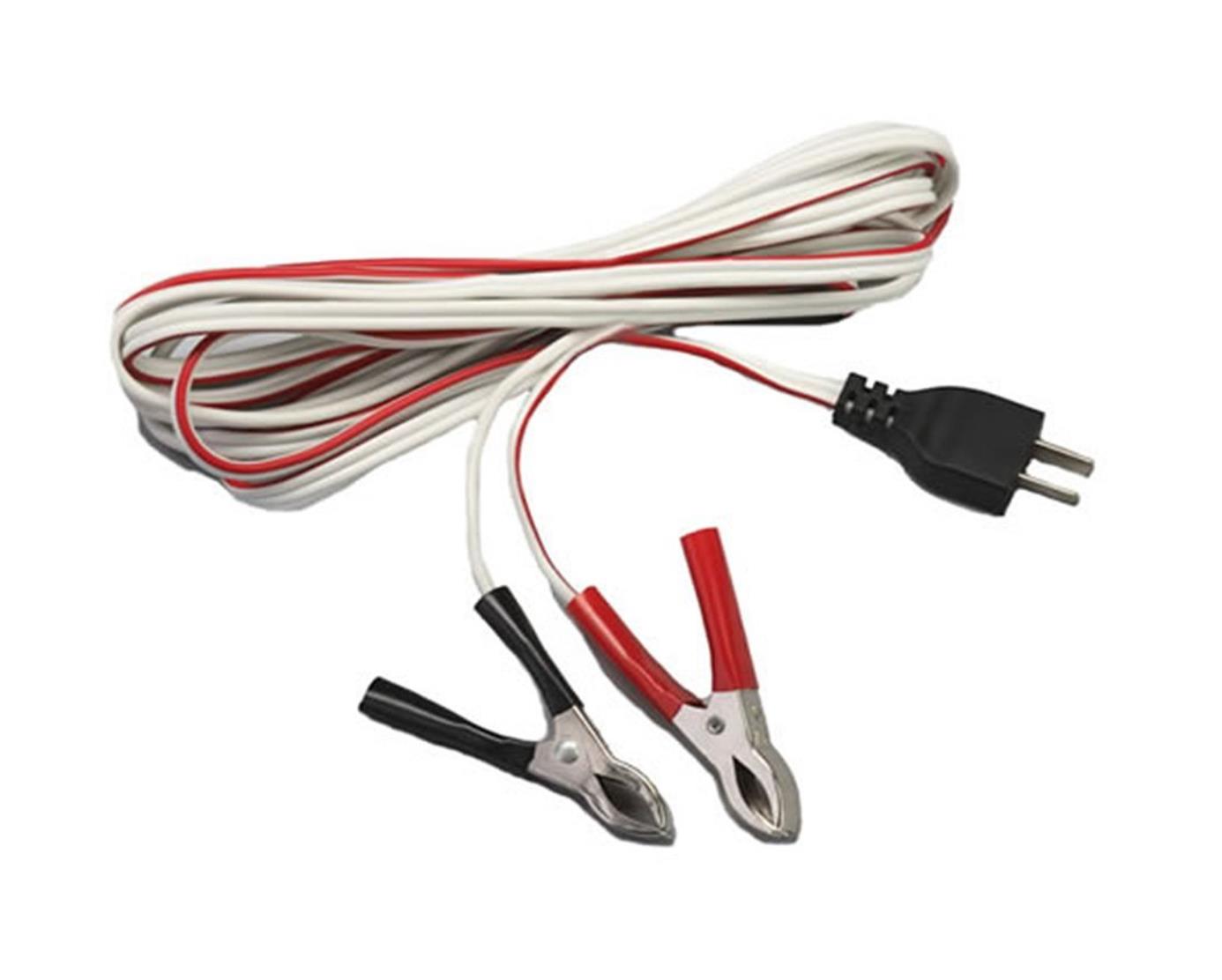
EU2000i Companion Control Panel
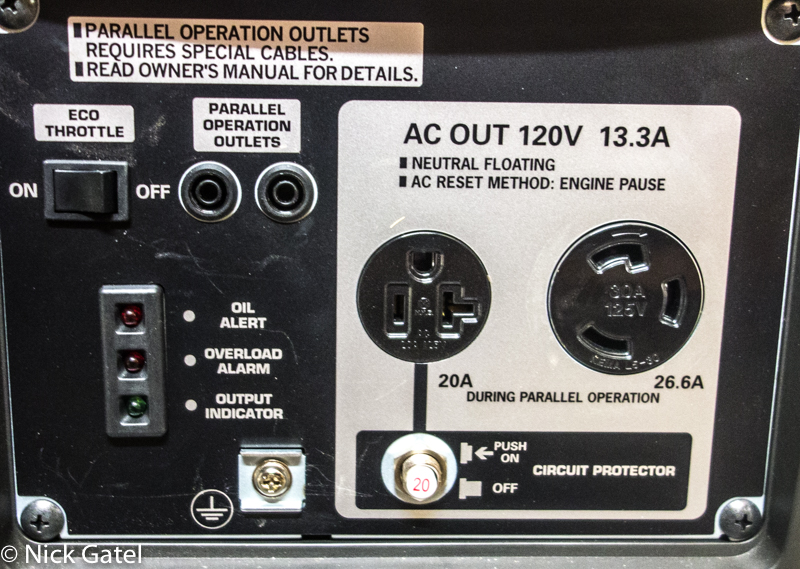
The left side is the same as the EU2200i and the EU2000i. The Companion generators have two receptacles. During parallel operation with another generator an RV 30 amp plug can be connected to the receptacle using a twist lock adapter.
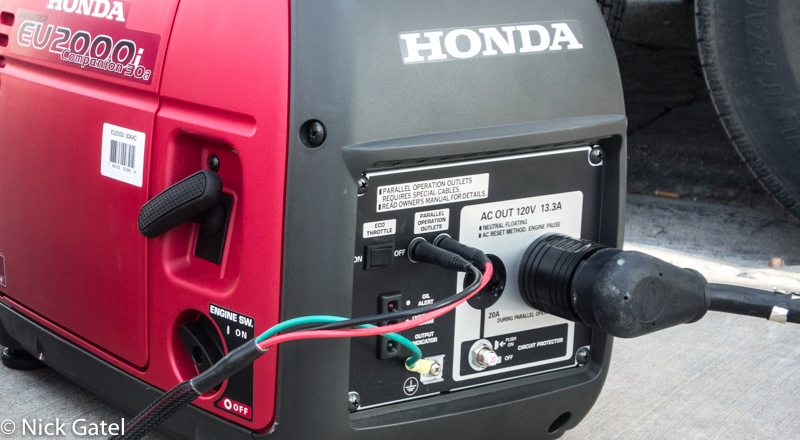
Operation
On our trip our campground only had 4 other campers. Since there are 150 campsites, we parked far from anyone else, and even though generator operation isn’t allowed between 10pm and 6am, we were able to run them since no one in the campground could hear them running. Success!!
Ordinarily I wouldn’t review a product after such a short period of time. I am familiar with engines (there is an engine inside the generator) and electronics, so the only other factor to consider would be durability and reliability. The Honda EU generators are legendary so that is a non-issue.
When the generators were first fueled it took a few pulls of the starter cord to fill the fuel pump and carburetor with gas. After that the generators started on the first pull every time.
Both fuel tanks hold .95 gallons of fuel.
At night I topped off the tanks just before we went to bed and turned off all circuit breakers in the camper except the air conditioner (didn’t want the battery charger or anything else to run and use excess fuel). Seven hours later the generators will still running, but were almost out of fuel. The inside of the camper was 76F and we were somewhat cold! Because the camper is fairly well insulated and the air conditioner cycles on and off, fuel consumption was outstanding. I will be buying an aftermarket extended run fuel tank (Honda doesn’t sell one).
We slept soundly and could barely hear the generators run – I’m hard of hearing, so we will use Joyce’s observations. I had put them right next to the bedroom to see how loud they were going to be. In the future we will move them away from the camper to mitigate all noise.
Other Stuff
It has been years since I bought a gas can and was quite surprised with this “no-spill” spout. It works exactly as advertised. What a great invention.
The biggest problem with these Honda generators is they are highly sought after by thieves.
There is little one can do to stop a determined thief, so deterrent is the only option – to slow down would be thieves so they move on to easier pickings. I bought two ½” braided steel cables and a couple top-of-the-line padlocks to secure them to the trailer when we are in camp. When we leave, we take them with us or lock them in the SUV if we are out hiking.
The handles of the generators are plastic and if cables are run through the handle, it is easy for the crooks to saw through the plastic…
…, so I bought a couple of these theft deterrent handle brackets.
If you need a generator, I highly recommend these Honda units. We won’t be taking them on most trips as our solar system has worked well for the past 5 years. However in the middle of summer and we are camping in the desert, we will take our generators and enjoy a nice cool interior at night!
There isn’t much discounting on these generators and Amazon is among the lowest resellers. But one thing I have learned in life is you get what you pay for. Often buying the cheapest item ends up costing more money because you end up buying what you should have bought the first time after that cheap items fails or doesn’t do what you want it to do.
This website may be compensated for linking to other sites for sales of products. As an Amazon Associate I earn a small fee from qualifying purchases at no additional cost to the purchaser.
(Update 12/14/2023): If you live in California you can’t buy these popular gasoline powered generators. The California Air Resources Board (CARB) has banned gas powered generators starting in 2028. The legislature didn’t banned them, the Governor apposite board did. Honda has quit selling them here. As I understand the rule (rules aren’t laws, but have the effect of laws), if someone already owns a generator they can continue to use it. Time will tell.
Auto Amazon Links: No products found.
OR INDIVIDUAL GENERATORS
SECURITY
BETTER SECURITY
